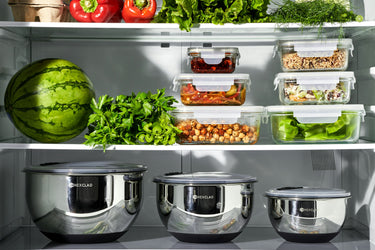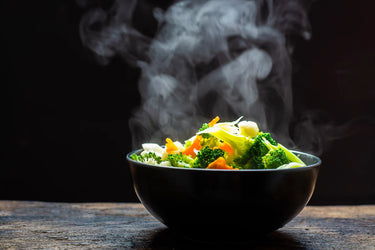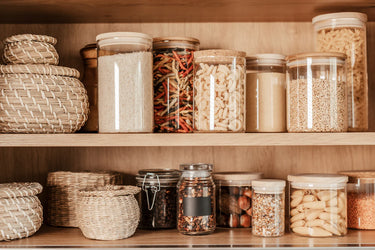How To Season Carbon Steel Pans: Step-by-Step Guide

Buying new cookware is always a fun and exciting experience. If you bought HexClad, you’re in for one of the best culinary experiences you’ve ever had. We bet you have a menu prepared with a mile-long list filled with all sorts of dishes you’ve been dying to create.
But before you do any of that, you need to season your pan. This process is incredibly beneficial to your cooking experience and the long-term success of your cookware. You may have heard a common myth about how cast iron skillets or similar metal alloys are the only types to need seasoning, but that isn’t the case.
Today we will talk about carbon steel and why you want to give it a good seasoning before its first use. But we won’t stop there. We will also break down the process to help make sure that your pans will thrive in the years to come.
What Is Carbon Steel Cookware?
Carbon steel cookware is made from carbon steel metal alloy. This metal alloy is made of 1 percent carbon and 99 percent iron. This combination creates one of the strongest and most versatile cookware options on the market.
Here at HexClad, we use a triple-clad technology that allows you to get the strength and lasting qualities from carbon steel and cast iron pans mixed with aluminum's heat-conducting capabilities and stainless steel's nonreactive qualities.
We also feature our signature peaks and valleys hexagonal etching on the pan's cooking surface, which helps get the most searing power and the highest-quality nonstick surface of the pan.
There’s just no beating the power of our hybrid cookware.
The benefit of using a hybrid pan is the sheer versatility in cooking techniques you can utilize with just one single piece of cookware. Many companies add a few different alloys together because they use subpar materials that need to be added just to create a good enough pan.
At HexClad, we use the best alloys to give you a pan that’s superior to the competition without breaking the bank. Carbon steel, stainless steel, and aluminum are all lightweight, strong alloys that are also light on the wallet.
They are cost-effective cookware options that outlast the competition, which gives them all the monetary value you could ever ask for from one awesome set of pots and pans.
Why Use Carbon Steel Cookware?
Carbon steel pans, woks, and pots have quite a range of benefits. They are the most well-rounded options on the market. It’s almost impossible to regret buying a carbon steel cookware set.
Carbon steel pans have a lot of versatility due to their strength. You can utilize this type of cookware with almost any heat source due to its protective coating, which allows it to withstand high heat temps. That means you can sear food in an oven-safe saute pan and immediately finish it with a broil in the oven without changing pans.
This is versatility and convenience rolled into one hard-working package.
Versatility doesn’t stop at the range. The durability behind carbon steel also makes it safe to throw in the dishwasher after dinner, taking your cleaning from “complicated” to “couldn’t get any easier.”
Lastly, carbon steel pans are strong but with a lightweight feel. Gone are the days of thinking that the heaviest pan on the market is also the best. Now you can get strength, durability, and range of use out of the lighter pans. Those pancakes can’t flip themselves after all.
We use carbon steel due to the strength it brings to the table. We combine it with the heat-conducting and heat-retention power of aluminum to get your pans heated up evenly and quickly, and add stainless steel to this powerful duo.
Stainless steel is highly resistant to corrosion or degradation, so together, this triple-clad pan is a true culinary superhero team.
Why Should You Season Carbon Steel Pans?
Most people think cast iron cookware is the only material that benefits from proper seasoning before use, but that is not the case. Seasoning a pan can protect your cooking surface against corrosion or degradation.
It can also help keep your ingredients from sticking to the pan or needing a heavy hand on oil to prevent this from happening. A seasoned pan will have a nonstick surface, keeping your ingredients slip-sliding around, even when cooking at medium-high heat. There’s nothing worse than perfectly preparing a salmon filet only to have it stick to the pan.
Another great example of this benefit is a stir-fried dish. Noodles are infamous for sticking to the pan, along with onions, peppers, and other popular ingredients in this kind of dish. These chopped pieces can stick to the pan, burn, and char, resulting in a disappointing dish, and possible damage to your pan.
You risk scratching or chipping if you have to do harsh scrubbing to clean your pan. Fortunately, that’s not the case with a properly seasoned HexClad pan.
How Should You Season Carbon Steel Cookware?
So your pans just arrived, and you’re ready to chop up your fresh ingredients. Hold your horses. You need to get those babies seasoned before adding anything to them.
Now we’ve explained to you why it’s so important to season your pans, but next, let’s break down how to get it done. A well-seasoned pan is not only your new BFF in the kitchen but the best sous chef you could ask for.
Treat it right, and it can help make your culinary dreams come true. Abuse your cookware, and the only magic you’ll be making in the kitchen is smoke — and reservations.
1. Wash the Pan
The first thing to do after taking the nonstick pan out of the packaging is to thoroughly wash it before the initial seasoning. Use warm water, a sponge, and dish soap to gently scrub your pan clean. Your pans arrived straight from our packaging department and came into contact with packing materials and different elements from the factory you don’t want in your food.
Each pan is hand-polished before packaging is done, so your pan may have a little residue left from that on it too.
2. Hand Dry the Pan
Once your pan has been cleaned, turn off the hot water, shake off excess water and dry your pan with a paper towel or dry kitchen towel. Allowing your pan to slowly air dry can potentially leave soapy water marks on the pans. That’s not an attractive look for your brand-new pans.
Properly and thoroughly dry your pan before moving on to the next steps. Any water or moisture left in the pan can react with the oil and heat and cause imperfections in your seasoning process.
3. Heat the Pan
Once your pan is completely dry, add it to the stovetop and set your burner to medium or low heat. You may have to resist the urge, but don’t turn your pan on any higher than this.
Our pans retain and conduct heat well, so you don’t have to blast the burner on high to get the right seasoning temperature. Put a pan on too high heat, and you run the risk of reaching the smoke point of your oil, which can cause the oil to turn rancid in your pan.
This can deteriorate the quality of your pan and the seasoning process.
4. Add a Bit of Oil to the Pan
Allow your pan about one to two minutes to heat up on the range. Add about one tablespoon of oil to your pan. You can use a variety of oils to season your pan.
These acceptable oils include:
- Vegetable oil
- Canola oil
- Olive oil
- Grapeseed oil
- Flaxseed oil
- Sunflower oil
- Peanut Oil
In addition, you definitely want to avoid butter or lard for seasoning cast iron, carbon steel, or stainless steel pans using the stovetop method of seasoning. These cooking fats won’t work as well as a standard cooking oil and can stain your pan.
Essentially, any neutral oil with a high smoke point can help you properly season your new carbon steel pan for the first time. Once your oil is in the pan, let it heat up for about one minute, then swirl it around in the pan to coat and season every inch of the cooking surface.
5. Burn the Oil
Once you’ve added a thin layer of oil to your frying pan, allow it to heat up and swirl around your pan for two to three minutes. Your oil will start to burn and smoke a little. It’s all ok. As long as you’ve kept the heat at the right temp, this smoking is just due to the heat that has been applied to the oil.
You need the oil to burn. The residual fats and oils left over after the seasoning process give your pan longevity. Do not rush this process. Fortunately, it’s fast. It shouldn’t take more than a few minutes max.
6. Wipe or Use the Pan
Wipe away excess oil and allow your pan to cool down. This won't take long, thanks to the metal alloys we combined for our pans. You can put your pan away once it’s cooled down (it won’t take long).
If you’re going to cook right away, you don’t need to let your pan cool down. You can even leave the oil in the pan you used for seasoning to cook your meal. The oil that is left in the pan is residual oil that is essentially left over from the seasoning process, so it’s safe to use without worrying about ruining your coating.
How Often Should You Re-Season Your Pans?
Your pan can stay perfectly seasoned for a long time. If you don’t cook often, you may notice that the seasoning doesn’t seem as clear or bright as the last time, but this process can take months or even a year.
Your seasoning should last. When you cook, the fats from your ingredients can add additional layers to the seasoning and coating. It can build on the original process. If your food isn’t sliding out of the pan as easily, or you are having trouble with certain ingredients like onions or peppers, your seasoning may be slowly disappearing.
At this point, it would be beneficial to season your pan again like before. This won’t hurt your pan or hinder its cooking capabilities, but if you allow the seasoning to completely disappear, your pan and meals could suffer as a result.
Typically, a proper seasoning process should at least last two to three years before you need to do it again. Your mileage may vary depending on what you cook and how often. If you need a little extra help, check out our video.
HexClad: The Best Carbon Steel in the Game
Here at HexClad, we pride ourselves on delivering the strongest, longest-lasting, and most durable cookware on the planet. But we don’t stop there. We also provide stay-cool technology on the handles, so you can get the most flip-and-toss action out of your pan without burning your palms.
What’s the point of a lightweight pan if you can’t easily handle the pan?
We are so confident that our pans will deliver that they come with a lifetime warranty. An adequately seasoned and well-maintained pan should last you a lifetime, but if something ever happens to your pan, let us know. We are that confident in our products and our technology.
If you’ve ever dreamed of cooking like the pros, here is your shot. Chefs like Gordon Ramsay believe in these pans. Our products are designed for professionals but made with our home chefs in mind.
Our easy-on-your-wallet price tag and the durability of our hybrid pans mean you’ll never have to buy a new set of cookware again.
Sources:
Polymerization: The Science of Cast Iron Seasoning | Lodge
What's a Smoke Point and Why Does it Matter? | Serious Eats





